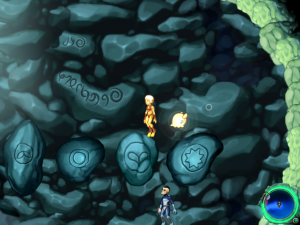Castlevania: Symphony of the Night
OK, so Yahtzee was talking about Castlevania: Symphony of the Night recently. And that led to some discussion with fellow gamers, which led to me purchasing a used copy on eBay 1I’m playing the original Playstation version, which I’m playing on my PS2, which is still the most recent console I own. And anyway, it seems like a good synthesis of the last two games I blogged about, Aquaria, a “metroidvania”-style 2D game with an emphasis on exploration, and Amnesia, a horror game set in a spooky castle. The fact that they all end in “-ia” seems to be coincidental, but maybe I should scour the Stack for other such games to see if there’s a pattern.
Not that Casltevania is a horror game exactly — it’s got a vampire antagonist and an over-the-top gothic style, but it’s more fantasy than anything else. In fact, this particular entry in the series has strong FRPG elements, which came as a surprise to me. My prior experience with the Castlevania series is slight, owing to growing up primarily a PC gamer. I recall watching a friend play one of the prior episodes when we were both in college, probably on the SNES, and I’ve played on an NES emulator the first few sections of the original — just enough for the first few segments of Symphony of the Night to be very familiar. Those experiences left me confused about the term “metroidvania”, which didn’t seem to describe the Castlevania I had seen at all. The reason, I now know, is that those weren’t the games that inspired the term. Symphony of the Night was, and that is the main reason I decided to play it.
So, to begin. This is a game where your ability to fight and survive is highly dependent on your equipment, and to emphasize this, it does something I’ve seen a few other games do: it starts you off in an extremely buff state, lets you play through an intro like that, and then takes it all away from you. In fact, it does this twice. The very opening of the game, before it plays the credits, is apparently the ending of the previous game, comprising a few stretches of corridor, a secret passage, and a boss fight against Dracula himself, in which he utters one of the most famous lines of awkward videogame dialogue to ever be loosely adapted from Japanese to English: “What is a man? A miserable little pile of secrets,” 2Yes, I realize he’s quoting Malraux. It hardly matters. which is right up there with “You spoony bard!” in my book. Throughout this section, the player controls Richter Belmont, vampire hunter and warrior supreme. But Richter goes missing during the opening credits, and for the rest of the game (as far as I’ve seen, anyway), you get a long-haired bishounen who looks like CLAMP drew him. Perhaps the success of this game is what inspired Hideo Kojima to attempt the same thing a few years later in Metal Gear Solid 2?
Well, maybe, maybe not. Regardless, it’s similar enough to make me wonder why the introduction of Raiden provoked so much fan outrage and the introduction of Alucard, Dracula’s half-vampire son, did not. It probably has something to do with the setting: Metal Gear ‘s military theming is a lot more macho than Castlevania‘s gothic, with its suggestion that immortality and super-powers are associated with aristocracy and poetic souls. But also, Alucard wastes no time in earning his badass cred. Where Raiden is presented at first as a newbie fresh out of the academy (his backstory later turns out to be a lie, but only after you’ve already formed a first impression of him) and spends his first few encounters hiding from guards, Alucard is out there taking out huge monsters with single blows of his terrible swift sword. Which, after a few rooms, is taken away from him, along with the rest of his stuff. But he still keeps his comet-trail of ghostly afterimages!
Anyway, I’m finding this game pretty compelling, and can see why people still like it despite the dated VGA-looking graphics and terrible, terrible dialogue. I’ll probably post again tomorrow.
 Comments(4)
Comments(4)